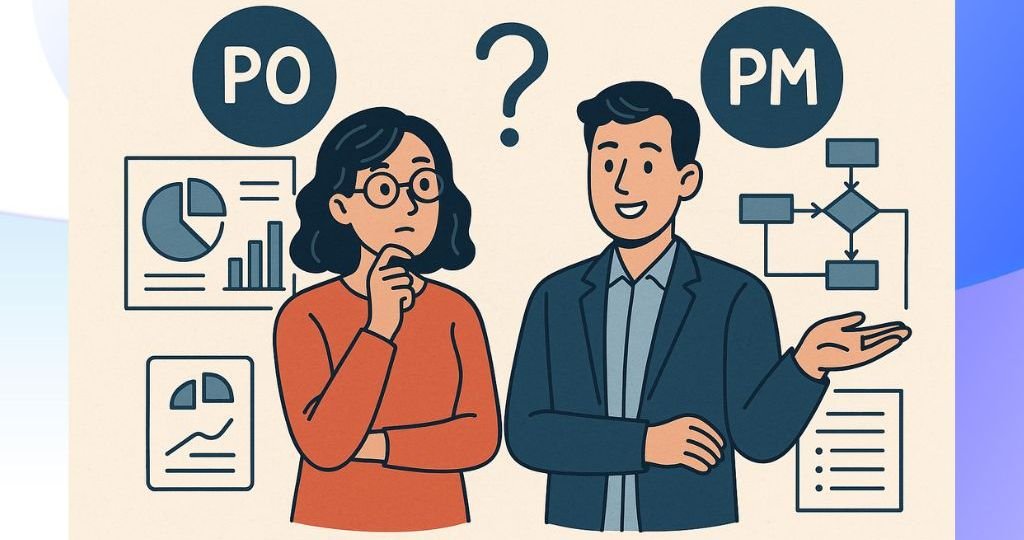
In the fast-paced world of IT projects, success hinges not only on technology and tools but also on clearly defined roles and seamless collaboration. Among the most pivotal — yet often misunderstood — roles are those of the Product Owner and the Project Manager. While both are essential to delivering value, their responsibilities, focus areas, and approaches differ significantly.
The Product Owner is the voice of the customer, driving the product vision, prioritizing the backlog, and ensuring that the development team delivers features that truly meet user needs. The Project Manager, on the other hand, is responsible for planning, execution, timelines, resources, and risk management — ensuring the project stays on track and within scope.
In this article, we’ll clarify their responsibilities, align their contributions for greater success, and explore how strategic vision and tactical execution can work hand in hand. By defining boundaries and bridging gaps, teams can avoid confusion, improve efficiency, and ultimately deliver better outcomes.
1. Clarifying Responsibilities for Better Collaboration
In the world of IT projects, smooth collaboration often depends on one crucial factor: clarity of roles. Two key figures frequently at the center of project delivery are the Product Owner (PO) and the Project Manager (PM). While their responsibilities can sometimes overlap, their core missions are distinct. The Product Owner champions the product vision, ensures that features align with user needs, and manages the backlog. On the other hand, the Project Manager keeps the project running efficiently — handling timelines, budgets, risks, and team coordination to ensure successful delivery.
When their roles are not clearly defined, teams can struggle with mixed messages, delayed decisions, and conflicting priorities. But when each role is understood and respected, collaboration becomes much more effective. The PO and PM aren’t competing — they’re complementary. The PO focuses on building the right product, and the PM ensures it’s built right. Clarifying these responsibilities is a simple step that can make a big difference in team performance and project outcomes.
2. Aligning Product Ownership and Project Management for Success
Bringing a digital product to life requires more than just technical skills — it demands strategic alignment between key roles. Among the most essential are the Product Owner (PO) and the Project Manager (PM). Although they approach projects from different angles, their collaboration is critical for achieving both product value and project efficiency. The Product Owner ensures the team builds the right features for users, while the Project Manager ensures the team delivers those features on time, within scope, and within budget. When these two roles are in sync, the path from idea to implementation becomes far more efficient and effective.
How to Foster Alignment Between the Product Owner and Project Manager ?
3. Strategic Vision Meets Tactical Execution
Successful IT projects require both a clear strategic vision and precise tactical execution — and that’s where the Product Owner and Project Manager shine as a team. The Product Owner sets the direction by understanding user needs, defining product goals, and prioritizing features that deliver the most value. This vision keeps the team focused on why they’re building the product. Meanwhile, the Project Manager translates that vision into actionable plans — managing timelines, resources, and constraints to ensure it gets delivered how and when it should. When strategy and execution are well-aligned, teams don’t just move fast — they move with purpose.
4. Defining Boundaries and Bridging Gaps Between Key Roles
One of the most common challenges in IT project teams is role overlap — or worse, role confusion. That’s why defining clear boundaries between the Product Owner and Project Manager is so important. Each role has its own focus: the PO is driven by product value and user experience, while the PM is focused on delivery, timing, and risk. When these boundaries are respected, it prevents duplicated efforts and conflicting directions. But clear boundaries alone aren’t enough — teams must also work on bridging the gaps between the roles. This means fostering open communication, sharing context, and making decisions together when their domains intersect. When the PO and PM operate in tandem, not in silos, the result is a more cohesive team and a stronger, more successful project.
You may also be interested in our article: The Product Owner in IT: The Bridge Between Vision and Execution
Feel free to share this article on your social networks, and if you have any questions, send us an e-mail. We’ll be happy to help. Follow our page regularly Pinterest for visual inspiration and new ideas.


